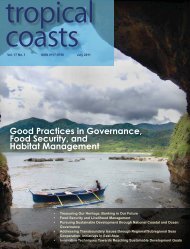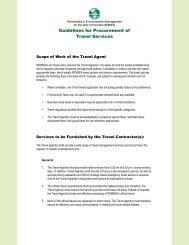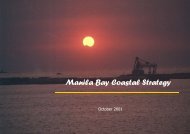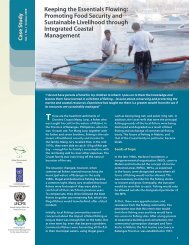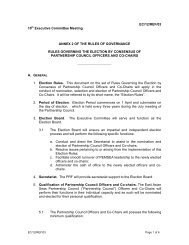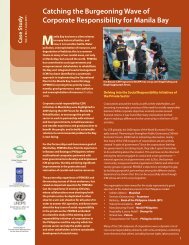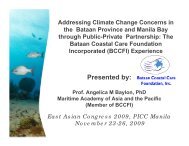Third East Asian Seas Youth Forum Toolkit - PEMSEA.org
Third East Asian Seas Youth Forum Toolkit - PEMSEA.org
Third East Asian Seas Youth Forum Toolkit - PEMSEA.org
- No tags were found...
Create successful ePaper yourself
Turn your PDF publications into a flip-book with our unique Google optimized e-Paper software.
Young Champions for the OceanGetting Ready for the <strong>Youth</strong> <strong>Forum</strong>This section introduces you to the “Partnership” behind the EAS Congress and the<strong>Third</strong> EAS <strong>Youth</strong> <strong>Forum</strong>.Partnerships in Environmental Management for the <strong>Seas</strong> of <strong>East</strong> Asia<strong>PEMSEA</strong> is a regional partnership programme funded by theGlobal Environment Facility (GEF), implemented by the UnitedNations Development Programme (UNDP) and executed bythe United Nations Office for Project Services (UNOPS). It is theregional coordinating mechanism for the implementation of theSustainable Development Strategy for the <strong>Seas</strong> of <strong>East</strong> Asia(SDS-SEA).The First Phase (1994-1999) was focused on Marine PollutionPrevention and Management in the EAS Region.The Second Phase (1999-2008) was focused on the broaderissue of sustainable development of marine and coastal areasthrough integrated coastal management (ICM), as well as thedevelopment of a regional strategy, the SDS-SEA. The SDS-SEAprovides a platform for governments and relevant <strong>org</strong>anizationsto coordinate their efforts to protect their shared ocean resource.This phase focused on Building Partnerships in EnvironmentalManagement for the <strong>Seas</strong> of <strong>East</strong> Asia.Currently on its <strong>Third</strong> Phase (2008 to present), <strong>PEMSEA</strong> nowserves as a regional partnership mechanism with a mandate toimplement the SDS-SEA.There are four major components to the partnership mechanism:a. The EAS Partnership Council as the intergovernmentalmulti-sectoral governing body;b. The Regional Partnership Fund that supports capacitydevelopment initiatives across the region for improvedimplementation of the SDS-SEA;c. The <strong>PEMSEA</strong> Resource Facility that providessecretariat and technical support services to Country andNon-Country Partners; andd. The EAS Congress.<strong>PEMSEA</strong> consists of 11 Country Partners, which includeCambodia, China, Democratic People’s Republic of Korea,Indonesia, Japan, Lao People’s Democratic Republic, Philippines,Republic of Korea, Singapore, Timor-Leste and Viet Nam.Aside from these, <strong>PEMSEA</strong> also has 19 Non-Country partnersincluding:• Asean Center for Biodiversity (ACB)• Conservation International Philippines• Coastal Management Center (CMC)• International Environmental Management of EnclosedCoastal <strong>Seas</strong> Center (EMECS)• International Ocean Institute (IOI)• International Union for Conservation of Nature andNatural Resources - Asia Regional Office• Korea Environment Institute (KEI)• Korea Maritime Institute (KMI)• Korea Ocean Research and Development Institute(KORDI)• Northwest Pacific Action Plan (NOWPAP)• Ocean Policy and Research Foundation (OPRF)• Oil Spill Response Limited (OSRL)• Plymouth Marine Laboratory• <strong>PEMSEA</strong> Network of Local Governments for SustainableCoastal Development (PNLG)• Swedish Environmental Secretariat for Asia (SENSA)• UNDP/GEF Small Grants Programme (SGP)• UNEP Global Programme of Action for the Protectionof the Marine Environments from Land-based Activities(UNEP/GPA)• UNDP/GEF Yellow Sea LME Project (YSLME)• UNESCO-IOC Subcommission for the Western Pacific(IOC/WESTPAC)Sustainable Development Strategy for the <strong>Seas</strong> of <strong>East</strong> AsiaVisionThe sustainable resource systemsof the <strong>Seas</strong> of <strong>East</strong> Asia are anatural heritage for the peopleof the region, a medium of accessto regional and global markets,and a safeguard for a healthyfood supply, livelihood, economicprosperity and harmonious coexistencefor present and futuregenerations.MissionTo build interagency, intersectoral and intergovernmentalpartnerships for achieving the sustainable development of the<strong>Seas</strong> of <strong>East</strong> Asia.Strategic Objectives• Sustain • Develop• Preserve • Implement• Protect • Communicate3



